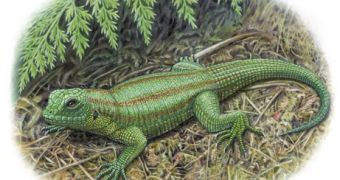Lizards wandered the world along with the dinosaurs. And even if small, they proved tougher, as they survived into the era of the mammals. A 130-million-year-old fossil found in the Ishikawa Prefecture of Japan and described by the journal "Paleontology" is the oldest found plant-eating lizard, a discovery with implications in both the evolution of lizards and plants. The jaw and skull suggest the lizard, called Kuwajimalla kagaensiswas, was 10 to 12 in (25 to 30 cm) long. The previously oldest found plant-eating lizard was Dicothodon, which inhabited North America 100 million years ago.
Amongst current lizards, exclusively plant-eating lizards are rare (just 3%), including large iguanas or some agamid lizards (the counterparts of the iguanas in the Old World), like spiny tailed lizards. Most lizards are insectivorous, carnivorous or omnivorous (eating both plant and animal stuff).
Living veggie lizards consume angiosperms (flowering plants), whose buds and leaves are usually soft. In this case, the new fossil would give an age of over 130 Ma to angiosperms, much earlier than showed by fossils.
"By finding this particular fossil from Japan, it might suggest that flowering plants were already there, but we don't have direct evidence yet," said co-author Makoto Manabe of Japan's National Science Museum, in Tokyo.
Lizards and angiosperms
The oldest found angiosperm is a 125-million-year-old Chinese fossil. Angiosperms have a sudden fossil emergence, not showing an evolutionary lineage like other groups. Some fossils of gymnosperms show the transition to angiosperms, but it's hard to say when they appeared.
The teeth of Kuwajmalla resemble those of living iguanas, thus this old lizard could have dined on the world's oldest flowers. Living gymnosperms, like coniferous, cycas and gingko, are less nutritious and much tougher to chew compared to flowering plants.
"If you're a dinosaur, your jaw is bigger, so it's OK. But lizards are small, and they have delicate teeth, so it is very difficult for them to eat and chop off very tough material," said Manabe.
One variant is that Kuwajmalla could have consumed fresh gymnosperm leaves.
"The big leaves are tough and fibrous. But the young ones tend to be softer and smaller," said Manabe.
This fossil changes the common view on lizard evolution.
"The ancestral condition for lizards has always been assumed to be insectivorous, so this new fossil provides data that challenges this thinking. The anatomical features of K. kagaensis suggest that either the ancestral condition for lizard diet was not as restricted as once thought or that diet has been highly labile [easily changed] throughout lizard evolution," said Christopher Austin, a herpetologist and curator at Louisiana State University's Museum of Natural Science.

 14 DAY TRIAL //
14 DAY TRIAL //